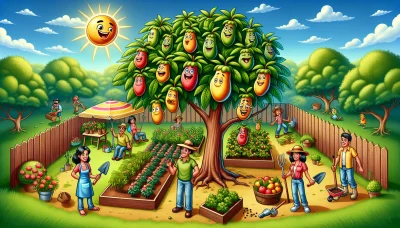What to do with guava Quiz
Test Your Knowledge
Question of
What to Do with Guava: A Gardener's Guide
Guava is not just a delicious and exotic fruit; it's also a versatile addition to any garden. Growing guava can bring a multitude of benefits, from its low maintenance nature to the abundance of fruit it produces. This tropical treasure can adapt to various soil types, making it accessible for many gardeners. Beyond its tasty fruit, guava leaves can be used for medicinal teas, offering health benefits such as improved digestion and reduced blood sugar levels. Whether you're looking to add a new fruit to your diet or seeking a plant that doubles as a natural remedy, guava is an excellent choice for enriching your garden and your well-being.
The Nutritional Benefits of Guava
Guava is a tropical fruit that is not only delicious but also packed with a variety of nutritional benefits. It is an excellent source of dietary fiber, vitamins C and A, potassium, and antioxidants. Eating guava can help improve digestion, boost the immune system, and lower the risk of chronic diseases. Its high vitamin C content helps in the absorption of iron from other foods, making it beneficial for those with anemia. Guava also contains lycopene, an antioxidant that can protect the skin from being damaged by UV rays and reduce the risk of cancer. With its low calorie and high fiber content, guava can also aid in weight loss and maintain a healthy heart. Including guava in your diet is a delicious way to support overall health.
Growing Guava: Tips and Tricks
- Choosing a Planting Site : Select a location with full sunlight and well-draining soil. Guavas prefer tropical or subtropical climates but can be grown in pots in cooler areas to move indoors during cold weather.
- Soil Preparation : Guavas thrive in a variety of soils but do best in rich soils with a pH between 5 and 7. Amend the soil with compost or manure before planting to improve fertility and drainage.
- Planting Guavas : If you're in a cooler climate, consider planting guava trees in pots. In warmer climates, plant guavas in the ground at the same depth as their nursery pot. Space trees 10 to 15 feet apart.
- Watering : Water newly planted guavas deeply to establish roots. Once established, guavas are relatively drought-tolerant but produce better fruit with regular, deep watering during dry periods.
- Fertilizing : Feed your guava tree every 1-2 months during the growing season with a balanced fertilizer. Reduce feeding in the winter months.
- Pruning : Prune guava trees in late winter or early spring to remove dead or diseased branches, to shape the tree, and to encourage air circulation and light penetration within the canopy.
- Pest and Disease Management : Keep an eye out for common pests like fruit flies, guava moths, and aphids. Use eco-friendly pesticides or introduce natural predators. Also, watch for signs of fungal diseases and treat with appropriate fungicides.
- Harvesting : Guava fruit is ready to harvest when it gives off a sweet, fragrant aroma and begins to soften. Harvest by hand, twisting the fruit off the branch. Frequent harvesting encourages the tree to produce more fruit.
Guava Recipes for Gardeners
- Classic Guava Jam
- Ingredients: Guavas, sugar, lemon juice.
- Instructions: Peel and mash guavas, mix with sugar and lemon juice, cook until thickened, and store in jars.
- Tropical Guava Smoothie
- Ingredients: Guava, banana, coconut milk, honey.
- Instructions: Blend all ingredients until smooth, serve chilled.
- Guava BBQ Sauce
- Ingredients: Guava paste, vinegar, tomato sauce, spices.
- Instructions: Combine ingredients in a saucepan, simmer until thickened, use as a marinade or sauce.
- Guava Cheesecake
- Ingredients: Cream cheese, guava paste, sugar, eggs, graham cracker crust.
- Instructions: Beat cream cheese, guava, and sugar, add eggs, pour into crust, and bake.
- Guava Salad Dressing
- Ingredients: Guava pulp, olive oil, vinegar, mustard, honey.
- Instructions: Whisk together all ingredients until smooth, season with salt and pepper.
Preserving Your Guava Harvest
There are several effective methods to preserve your guava harvest, ensuring you can enjoy this delicious fruit long after the season has ended. Freezing is a straightforward approach; simply wash, peel, and cut the guavas into slices or cubes, then freeze them on a tray before transferring to a freezer-safe container. This method retains the fruit's flavor and nutritional value. Drying guavas, either in a dehydrator or a low oven, concentrates the fruit's sweetness and extends its shelf life significantly, making for a chewy, healthy snack. Canning is another excellent preservation method, allowing you to enjoy guavas in jams, jellies, or even as a preserved whole fruit. Each method has its own charm, offering different ways to savor guavas throughout the year.
Common Pests and Diseases Affecting Guava Trees
| Pests/Diseases | Symptoms | Prevention/Treatment |
|---|---|---|
| Fruit Flies | Larvae inside the fruit, leading to rot | Use fruit fly traps; harvest fruits early |
| Guava Moth | Caterpillars feeding on leaves and fruit | Apply Bacillus thuringiensis; remove affected fruits |
| Anthracnose | Dark, sunken lesions on fruits; leaf spots | Fungicide applications; prune to improve air circulation |
| Guava Wilt Disease | Wilting and yellowing of leaves; tree death | Use resistant varieties; ensure good drainage |












